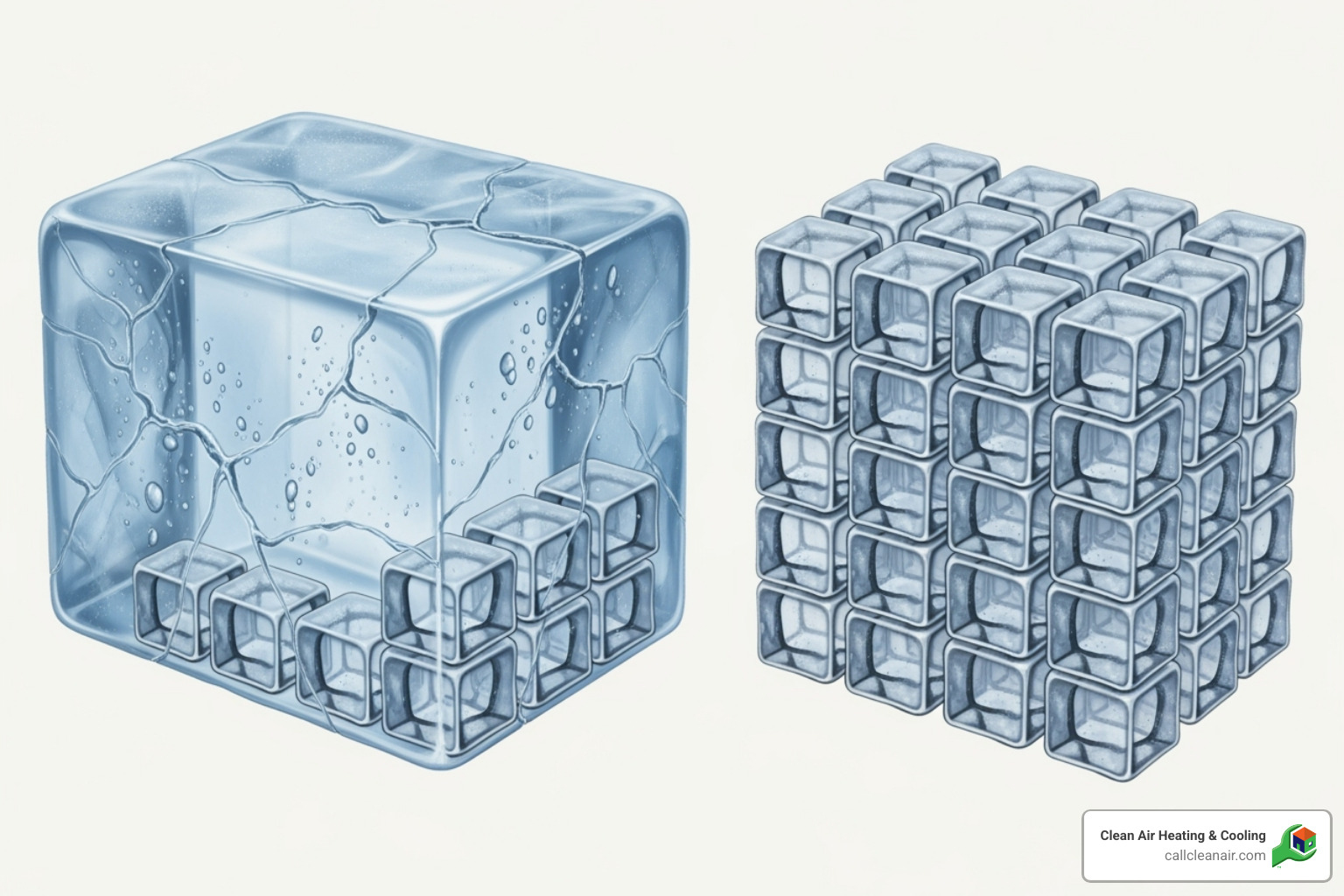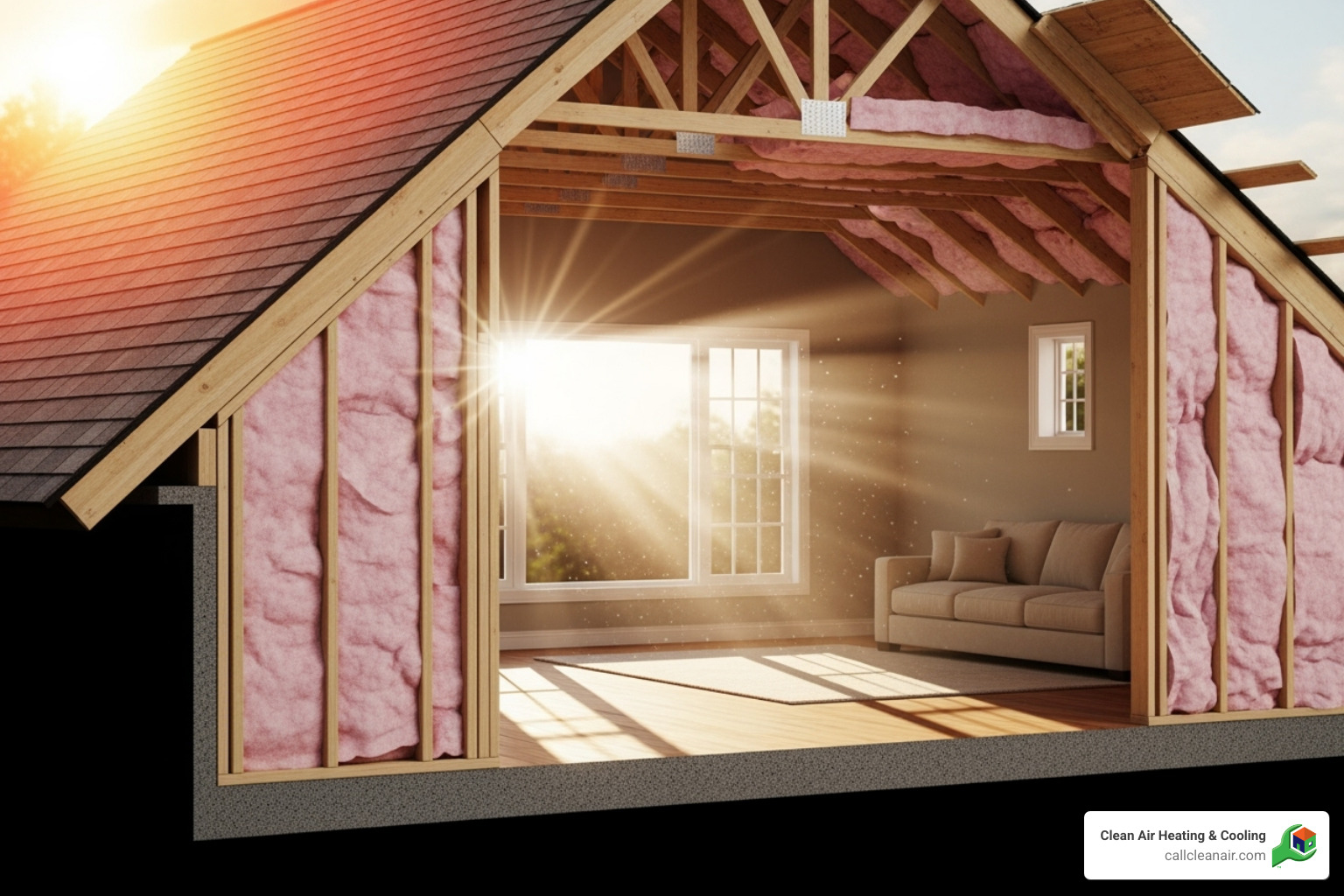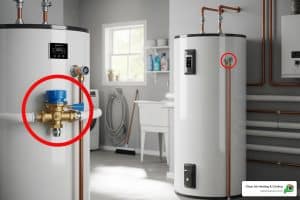Why Proper AC Sizing is More Than Just a Guess
AC sizing is the critical process of determining the exact cooling capacity your home needs. Getting it wrong can cost you thousands in energy bills and repairs. Here’s what you need to know:
Quick AC Sizing Guide:
- Too Small: Runs constantly, never reaches desired temperature, high energy bills
- Too Large: Short cycles, poor humidity control, wastes energy
- Just Right: Runs efficiently, maintains comfort, optimal energy use
- General Rule: 20 BTU per square foot (but professional calculation recommended)
- Standard Sizes: 1.5 to 5 tons for most homes (1 ton = 12,000 BTU)
In the Pacific Northwest, a correctly sized AC is crucial for comfort, health, and avoiding high energy bills during summer heat waves. The stakes are higher than most homeowners realize.
Unfortunately, industry estimates suggest up to 90% of HVAC systems are improperly sized or installed. This means most homeowners face inadequate cooling or inflated energy bills from systems that fail to control humidity.
Proper AC sizing goes beyond square footage, considering factors like insulation, windows, ceiling height, sun exposure, and occupancy to find the perfect fit.
Bigger isn’t always better when it comes to air conditioners. An oversized unit cools too quickly, cycling on and off without removing humidity, which leads to a clammy environment and potential mold growth.
This guide covers everything from BTUs and tonnage to the key factors for your home’s cooling load. We’ll explain why professional Manual J calculations are essential and how to avoid common sizing mistakes.
I’m Colin Matei, Owner of Clean Air Heating & Cooling. For years, I’ve helped families in Whatcom, Skagit, and Snohomish Counties find perfect AC sizing solutions. My experience confirms that proper sizing is the foundation of an efficient cooling system.

The “Goldilocks” Problem: Consequences of Incorrect Sizing
With AC sizing, you face the “Goldilocks Problem”: the system must be just right. An incorrect size leads to a cascade of issues beyond simple discomfort. An incorrectly sized AC is like ill-fitting shoes—either way, you’re uncomfortable and inefficient.
A key sign of poor AC sizing is short cycling (frequent on/off cycles). This leads to high humidity, increased energy bills, and premature system failure.
As an HVAC professional, my main concern is humidity. Poor humidity control isn’t just uncomfortable; it creates ideal conditions for mold. The Dangers of Mold Growth can pose serious health risks to your family.
The Dangers of an Undersized AC Unit
An undersized AC is like filling a pool with a garden hose—it’s fighting a losing battle. It runs constantly but fails to reach the set temperature, leaving you perpetually adjusting the thermostat for relief that never arrives.
This results in higher utility bills from non-stop energy consumption and excessive wear and tear, leading to frequent repairs and early replacement.
If your AC runs constantly but doesn’t cool your home, it’s likely a sizing issue, not just a mechanical problem. Our guide on Signs My HVAC System Needs Repair can help you tell the difference.
The Hidden Problems of an Oversized AC Unit
An oversized unit seems better, but it’s like using a race car for a daily commute—powerful but impractical. It creates frequent on/off cycles by cooling the space too quickly, shutting down before it can properly dehumidify the air.
This leads to wasted energy and inadequate dehumidification, creating that clammy, uncomfortable feeling even when the temperature is low. The constant starting and stopping puts increased strain on components, wearing them out faster.
Worse, high humidity invites mold and mildew into your home and ductwork.
Decoding AC Capacity: BTUs, Tons, and Efficiency
Shopping for an AC involves a lot of acronyms, but understanding them is simple. Think of it like car specs: BTUs and tons are power, while SEER2 is fuel efficiency.

What is a BTU (British Thermal Unit)?
A British Thermal Unit (BTU) is a standard measure of energy. As the Energy Information Administration explains, it’s the energy needed to heat one pound of water by one degree Fahrenheit.
For ACs, it measures how much heat a unit can remove per hour. A 24,000 BTU unit removes that much heat from your home hourly. A higher BTU rating means more cooling power, making it the foundation of proper AC sizing calculations.
From BTUs to Tons: Understanding AC Power
The industry also uses “tons” to measure capacity. This historical term isn’t about weight; it dates back to when ice was used for cooling.
One ton of cooling capacity equals 12,000 BTUs per hour, the cooling power of one ton of ice melting over 24 hours.
Residential ACs typically range from 1.5 to 5 tons, sold in half-ton increments. For example, a 1.5-ton unit is 18,000 BTUs, and a 3-ton unit is 36,000 BTUs.
You can often find the tonnage in the model number on your outdoor unit. For example, a number containing “24” usually indicates 24,000 BTUs, or 2 tons.
Beyond Power: What is a SEER2 Rating?
Beyond power, efficiency is key. The SEER2 rating is like an AC’s MPG, measuring how efficiently it converts electricity into cooling.
SEER2 (Seasonal Energy Efficiency Ratio 2) measures seasonal cooling output versus energy input. A higher SEER2 means better efficiency and lower bills.
Federal standards now require a minimum SEER2 of 14-15. Standard systems are often 14-16 SEER2, while high-efficiency models can exceed 22 SEER2.
ENERGY STAR® certified units are even more efficient. Understanding the difference between ratings, like in our guide on What is the Difference Between SEER & EER Ratings?, helps you make a smart investment. Higher SEER2 ratings lead to significant savings on utility bills, especially during Pacific Northwest heat waves.
Key Factors for an Accurate AC Sizing Calculation
Proper AC sizing is a puzzle where square footage is just one piece. Many factors determine your home’s cooling needs, and understanding them is key to a comfortable, cost-effective system.

Your Home’s Blueprint: Square Footage, Ceiling Height, and Layout
The 20 BTUs per square foot rule is a starting point (e.g., a 1,500 sq ft home suggests a 2.5-ton unit), but it’s too simplistic. Vaulted ceilings increase the volume of air that needs cooling, requiring more power than standard 8-foot ceilings. The layout also matters. An open-concept design allows heat to spread easily, while a compartmentalized layout contains it, affecting cooling needs differently.
Here’s a starting point for AC sizing based on square footage, though remember – this is just the beginning of the calculation:
| Square Footage (sq ft) | Estimated BTU (BTUh) | Estimated Tonnage (tons) |
|---|---|---|
| 600 – 1,000 | 18,000 | 1.5 |
| 1,000 – 1,300 | 24,000 | 2 |
| 1,300 – 1,600 | 30,000 | 2.5 |
| 1,600 – 1,900 | 36,000 | 3 |
| 1,900 – 2,200 | 42,000 | 3.5 |
| 2,200 – 2,600 | 48,000 | 4 |
| 2,600 – 3,200 | 60,000 | 5 |
Location, Location, Location: Climate Zones and Sun Exposure
The Pacific Northwest’s climate zone is crucial for AC sizing. Our milder but humid summers require careful consideration to manage moisture effectively.

Sun exposure, especially from south- or west-facing windows, can increase cooling needs by 10-15%. This “solar gain” is a major factor. A home’s orientation is critical; a west-facing room can be much hotter than a north-facing one. The U.S. Department of Energy climate zone guide details these regional differences.
Your Home’s Envelope: Insulation and Windows
Your home’s envelope (walls, roof, windows) acts as a thermal barrier. A better envelope means less work for your AC and affects AC sizing. Good insulation (high R-values) in walls and attics can reduce cooling needs by 10-15%. Energy-efficient windows (double- or triple-pane with low-E coatings) are also crucial for preventing heat gain.
Air leakage from gaps around windows and doors undermines cooling efforts. Proper sealing and duct maintenance, as detailed in The Benefits of Duct Cleaning, can significantly reduce your cooling load.
The People and Things Inside: Occupancy and Heat Load
People generate heat; each person adds about 400 BTUs to the cooling load. Appliances and electronics also produce heat. Kitchens, laundry rooms, and home offices are significant heat sources that add to the cooling load your AC must overcome.
AC sizing must account for the space and everything in it, which is why professional load calculations are essential.
The Professional Standard: Why a Manual J Calculation is Best
Online AC sizing calculators are convenient but unreliable. They miss crucial details about your home, leading to costly mistakes. These tools and simple rules of thumb can’t account for your home’s unique layout, climate, or other factors, often resulting in incorrect AC sizing and the problems that come with it.
A professional assessment is vital to ensure your system delivers optimal performance, comfort, and energy savings.
What is a Manual J Calculation?
A Manual J calculation is like a comprehensive physical for your home’s cooling needs, going far beyond square footage. Developed by the Air Conditioning Contractors of America (ACCA), it’s the industry-standard method for accurate AC sizing.
This meticulous, room-by-room analysis considers:
- Location & Climate: Precise local data for the Pacific Northwest.
- Home Orientation: How sunlight hits your home.
- Construction: Insulation R-values, building materials, and foundation type.
- Windows & Doors: Size, type, efficiency, and shading.
- Air Tightness: Identifying and accounting for air leaks.
- Internal Heat Gains: Heat from occupants, lighting, and appliances.
- Ductwork: The condition and efficiency of your existing ducts.
How Different AC Systems Affect Your Sizing Choice
While Manual J determines your home’s total cooling load, the type of AC system you choose also influences the final sizing and installation.
Central split systems use an outdoor unit and indoor air handler to distribute cool air via ductwork. Manual J determines the total tonnage needed for the whole home.
Packaged units combine all components into one outdoor cabinet. The sizing principles are the same, but the installation is different.
Ductless mini split systems offer an alternative with zone control. While Manual J still determines the overall cooling load, mini-splits allow you to cool specific rooms or areas with individual indoor units. For a home needing 3 tons of cooling, you could use one central 3-ton unit or multiple mini-split units to cool only the occupied spaces. This zoning can lead to significant energy savings. Learn more about Ductless Mini Split Systems.
Costs, Rebates, and Common Mistakes
Understanding the finances of AC sizing and installation can save you thousands. There are also rebates and incentives that many homeowners overlook.
Typical AC Installation Costs and Available Rebates
AC installation costs vary based on the unit’s size, type, and efficiency (SEER2), as well as installation complexity and any needed ductwork or electrical upgrades. Investing in proper AC sizing and a high-efficiency unit pays off. A correctly sized, modern unit can reduce energy use by 25-35%, leading to significant annual savings.
At Clean Air Heating & Cooling, we’re so confident that we offer a 25% utility savings guarantee. Request a no-pressure AC Installation Estimate to see what you could save.
You don’t have to cover the full cost alone. Rebates from federal, state, and local utility programs can significantly reduce your out-of-pocket expense. In Northwest Washington, we help homeowners access programs like PSE Rebates and other local incentives. We always check for the latest opportunities for your project.
Top 3 AC Sizing Mistakes to Avoid
Over the years, I’ve seen homeowners make the same avoidable mistakes:
- The “Bigger is Better” Myth: This is the most common and costly mistake. An oversized unit will short cycle, waste energy, and fail to control humidity, leaving your home feeling clammy.
- Assuming the Old Unit’s Size is Correct: Never assume the old unit was sized correctly. It may have been wrong from the start, or your home’s efficiency may have changed. Always get a new assessment.
- Forgetting Home Improvements: If you’ve added insulation or new windows, your home is more efficient and your cooling load is lower. This often means you need a smaller AC unit than before. Failing to account for this can lead to installing an oversized system.
The bottom line: Proper AC sizing is a crucial investment. Get it right, and you’ll enjoy comfort and savings for years.
Frequently Asked Questions about AC Sizing
Here are the three most common questions we get about AC sizing.
What size AC do I need for a 2,000 sq ft house?
A general estimate for a 2,000 sq ft house is a 3-ton (36,000 BTU) unit. However, this is just a starting point. Factors like ceiling height, insulation levels, window quality, and sun exposure can dramatically change your needs. A well-insulated home might only need a 2.5-ton unit, while a poorly insulated one could require 4 tons. This significant difference is why a professional Manual J calculation is essential for accurate AC sizing; we never rely on square footage alone.
Can I just replace my AC with the same size unit?
We strongly advise against simply replacing your AC with the same size unit for three key reasons:
- The original unit may have been sized incorrectly. Up to 90% of systems are improperly sized, so you could be repeating a past mistake.
- Your home has likely changed. New windows, added insulation, or other efficiency upgrades reduce your cooling needs, often meaning you require a smaller unit.
- Modern units are more efficient. A new, high-efficiency unit can provide better cooling with less capacity than an older model.
A fresh assessment ensures your new system is sized correctly for your home as it is today.
How does humidity affect the AC size I need?
Humidity is a critical factor in AC sizing, especially in the Pacific Northwest. Your AC’s second job is to act as a dehumidifier.
An oversized AC cools the air too quickly and shuts off before it has a chance to remove adequate moisture. This leaves your home feeling cool but clammy and can promote mold growth.
A properly sized system runs for longer, more consistent cycles. This gives it the time needed to both lower the temperature and effectively pull humidity from the air, resulting in true comfort and a healthier indoor environment. Proper sizing is the key to controlling both temperature and humidity.
Conclusion: Get the Perfect Fit for Your Home
Proper AC sizing is about creating a comfortable sanctuary for your family. As we’ve shown, it’s the key to avoiding the high costs and poor comfort of an incorrectly sized system.
Key Takeaways: Sizing is more than square footage; it includes your home’s unique features. Bigger is not better, as it leads to wasted energy and high humidity. Always insist on a professional Manual J calculation over simple estimates.
In Whatcom, Skagit, Snohomish, and San Juan Counties, our humid summers demand an AC that effectively dehumidifies. An incorrectly sized system will fail at this crucial task.
At Clean Air Heating & Cooling, we get it right the first time. Our professional Manual J calculations ensure a perfect fit for your home. Backed by over 480 five-star reviews and our 25% utility savings guarantee, we deliver the ideal balance of comfort and efficiency.
Don’t rely on guesswork. Whether you want a central AC or are exploring Ductless Mini Split Systems, we can help. Contact us today for a professional assessment to take the mystery out of AC sizing and ensure years of comfort.




